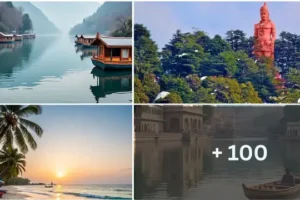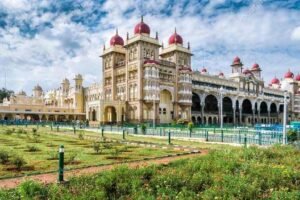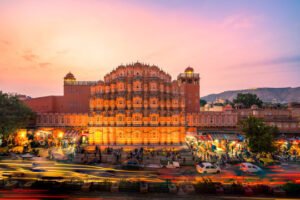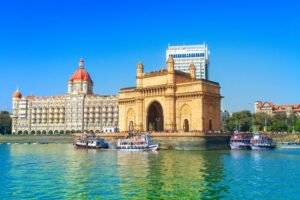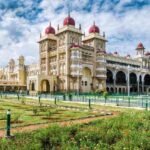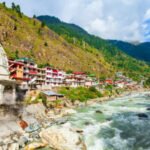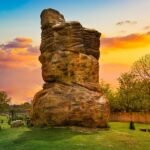Introduction to Sirmaur
Nestled in the southern region of Himachal Pradesh, the picturesque district of Sirmaur stands as a beacon of natural splendor and historical richness. Sirmaur, often lauded for its lush landscapes and serene environment, offers travelers an enticing combination of breathtaking scenery and cultural depth. As you meander through its verdant valleys and forested hills, it becomes apparent why Sirmaur has gained prominence as a must-visit destination.

Sirmaur’s history dates back to ancient times, with numerous relics and folklore adding layers of intrigue to its cultural fabric. This district is a repository of heritage, dotted with historic temples, fortresses, and colonial-era buildings that tell the tale of a significant past. The cultural significance of Sirmaur is palpable in its festivals, local customs, and the warmth exuded by its communities, making it a captivating spot for cultural enthusiasts and history buffs alike.
The natural beauty of Sirmaur is undeniably one of its most compelling attributes. The region is endowed with a plethora of landscapes, from terraced fields and dense forests to shimmering rivers and tranquil lakes. These natural settings not only provide an idyllic backdrop for photography and relaxation but also offer myriad opportunities for adventure activities such as trekking, bird watching, and river rafting. As you explore the district, the symphony of nature’s elements, coupled with the fresh mountain air, creates an ambiance of serenity and rejuvenation.
Moreover, the local communities of Sirmaur add to the district’s allure with their hospitality and vibrant way of life. The distinctive Himachali culture, with its traditional attire, cuisine, and festivals, adds a unique charm that enhances the travel experience. In summary, Sirmaur stands out as a destination where natural beauty and cultural richness converge harmoniously, making it an enriching destination for travelers seeking both adventure and tranquility.
Best 15 Tourists Places to Visit in Sirmaur
Best 15 Tourists Places to Visit in Sirmaur
Sirmaur is in the south eastern corner of the state. It is famous for its places of pilgrimages and for the legends that surround them. Nahan is a historic town pleasantly located on a ridge of the Shivalik Hills. It has beautiful green forests and valleys especially in Choordhar peak. A little town with a salubrious climate Nahan has gardens, temples and three popular walking circuits – The villa round, Military round and the Hospital round.
1. Renuka Lake
Renuka Lake: A Serene Himalayan Gem
Renuka Lake is a picturesque natural lake located in the Sirmaur district of Himachal Pradesh, India. Renowned for its serene beauty and rich cultural significance, it’s a popular tourist destination.
Key Features
- Largest Lake in Himachal Pradesh: Renuka Lake holds the distinction of being the largest lake in the state.
- Ramsar Site: Due to its ecological importance, the lake was designated as a Ramsar site in November 2005.
- Mythological Significance: The lake is named after Goddess Renuka, the wife of sage Jamadagni and mother of the Hindu deity Parashuram.
- Wildlife Sanctuary: The surrounding area has been declared a wildlife sanctuary, home to various flora and fauna.
- Recreational Activities: Visitors can enjoy boating, fishing, trekking, and birdwatching around the lake.
Why Visit Renuka Lake?
Relaxation: The serene atmosphere of the lake is ideal for unwinding and rejuvenating.
Natural Beauty: The lake’s tranquil waters surrounded by lush green hills offer a peaceful and scenic environment.
Cultural Significance: The lake’s connection to Hindu mythology adds to its allure.
Adventure Activities: For those seeking adventure, the surrounding area offers opportunities for trekking and exploring.
2. Nahan
Nahan is a charming hill station nestled in the Shivalik Mountains of Himachal Pradesh, India. Known for its serene beauty, pleasant climate, and cultural significance, it offers a tranquil escape from bustling city life. Here are some key points about Nahan:
Highlights
- Scenic Beauty: Surrounded by lush forests and majestic mountains, Nahan boasts picturesque landscapes and stunning views.
- Pristine Lakes: The town features several beautiful lakes, including the man-made Nahan Lake and the nearby Renuka Lake.
- Ancient Temples: Explore the rich spiritual heritage of Nahan by visiting its ancient temples, such as the Trilokpur Temple and the Shivalik Temple.
- Cultural Significance: Nahan was once the capital of the Sirmur princely state and retains its historic charm, evident in its architectural heritage and cultural traditions.
- Adventure Activities: Enjoy outdoor activities like trekking, hiking, and birdwatching in the surrounding hills and forests.
Attractions
- Nahan Lake: A serene man-made lake surrounded by gardens, offering boating and picnicking opportunities.
- Renuka Lake: A natural lake known for its scenic beauty and wildlife, perfect for boating and birdwatching.
- Trilokpur Temple: A sacred Hindu temple dedicated to Goddess Mahamaya Bala Sundri, attracting devotees from far and wide.
- Shivalik Temple: An ancient temple located on a hilltop, offering panoramic views of the town and surrounding mountains.
- Suketi Fossil Park: A unique attraction showcasing fossils of ancient plants and animals, providing insights into the region’s geological history.
Climate:
Nahan experiences a pleasant climate throughout the year, with mild summers and cool winters. The best time to visit is during the spring (March-May) or autumn (September-November) when the weather is comfortable and the scenery is at its best.
How to Reach
Road: Nahan is well-connected by road to major cities in India, with frequent bus services and taxi availability.
Air: The nearest airport is Chandigarh Airport, located about 82 kilometers away.
Train: The nearest railway stations are Ambala (69 km) and Chandigarh (79 km).
3. Choordhar Peak
Choordhar Peak, also known as Churichandni Dhar, is a prominent peak in the Shivalik range of the Himalayas, located in Sirmaur district, Himachal Pradesh, India. It is the highest peak in the outer Himalayas, standing at a height of 11,965 feet (3,648 meters).
Some key points about Choordhar Peak:
- Height: 11,965 feet (3,648 meters)
- Location: Sirmaur district, Himachal Pradesh, India
- Significance: Highest peak in the outer Himalayas
- Religious importance: Home to the ancient Srigul temple dedicated to Shiva
- Trekking destination: Popular among trekkers and hikers due to its moderate difficulty level and stunning views
- Flora and fauna: Rich in biodiversity, with a variety of alpine plants and wildlife
- Snowfall: Receives significant snowfall, especially during winter months
- Views: Offers panoramic views of the surrounding mountains, including the snow-capped peaks of Badrinath and Kedarnath
- History: George Everest, the surveyor who measured Mount Everest, made astronomical readings from Choordhar Peak.
4. Rajgarh Valley
Nestled amidst apple orchards, Rajgarh Valley is a tranquil retreat with scenic beauty and a peaceful atmosphere. Rajgarh Valley is a picturesque valley located in the Sirmaur district of Himachal Pradesh, India. It’s also known as “Peach Valley” due to the abundance of peach orchards in the region. Here are some key features and attractions:
Natural Beauty
- Scenic Landscapes: The valley offers breathtaking views of lush green hills, pine forests, and rivers.
- Churdhar Peak: A popular trekking destination, Churdhar is the highest peak in the region, offering panoramic views of the Himalayas.
- Baru Sahib Gurdwara: A significant Sikh shrine located on the banks of the Giri River.
Activities
- Camping: Enjoy riverside camping at Camp Peach Valley, offering a peaceful and comfortable experience.
- Trekking: Explore the surrounding trails and discover hidden gems in the valley.
- Wildlife: Spot various bird species and other wildlife in the nearby forests.
Local Culture
- Religious Significance: The valley is home to several religious sites, including the Shaya temple and the Baru Sahib Gurdwara.
- Warm Hospitality: Experience the friendly and welcoming nature of the local people.
Climate
Winters: While the winters can be cold, snowfall is rare in the valley.
Pleasant: The climate is moderate throughout the year, making it a suitable destination for visitors.
5. Paonta Sahib
A significant Sikh pilgrimage site, Paonta Sahib is where the Sikh Guru Gobind Singh was born. The gurdwara here is a beautiful structure with serene surroundings. Paonta Sahib is a historical town located in Sirmaur, Himachal Pradesh, India. It is situated on the banks of the Yamuna River and is known for being the birthplace of the Sikh Guru Gobind Singh.
Some key points about Paonta Sahib:
Tourist Attractions: Apart from the Gurudwara, the town also offers other attractions such as the Surajgarh Fort and the Bhimgarh Fort.
Historical Significance: The town holds immense historical significance as the birthplace of Guru Gobind Singh, the tenth Sikh Guru.
Religious Importance: Paonta Sahib is a popular pilgrimage site for Sikhs worldwide. The Gurudwara Paonta Sahib is a major place of worship and attracts numerous devotees.
Yamuna River: The town is situated on the banks of the Yamuna River, which is a sacred river in Hinduism.
Natural Beauty: Paonta Sahib is surrounded by scenic beauty, with hills and forests in the vicinity.
6. Trilokinath Cave Temple
Trilokinath Cave Temple: A Divine Retreat in Himachal Pradesh
Trilokinath Cave Temple is a renowned Hindu temple nestled amidst the picturesque landscapes of Sirmaur, Himachal Pradesh, India. Dedicated to Lord Shiva, the temple is believed to be one of the oldest shrines in the region.
A Natural Wonder
The temple is situated inside a natural cave, creating a serene and spiritual atmosphere. The cave, with its intricate rock formations, is a marvel of nature. A stalagmite Shiva lingam, believed to be the meditation spot of Lord Shiva, is installed within the cave.
Legend and Beliefs
According to local folklore, the cave was once adorned with gold. When a shepherd attempted to steal the gold, Lord Shiva intervened, transforming the gold into rock. This legend adds to the mystique and spiritual significance of the temple.
A Pilgrimage Site
Trilokinath Cave Temple is a popular pilgrimage site, attracting devotees from far and wide. The temple’s peaceful ambiance and the belief in its divine energy make it a spiritual retreat for many.
Key Features:
- Natural Cave: The temple is housed within a beautiful natural cave.
- Shiva Lingam: A stalagmite Shiva lingam is the main deity of the temple.
- Legend: The temple is associated with a fascinating legend about gold and divine intervention.
- Pilgrimage Site: It is a popular destination for Hindu pilgrims.
7. Bhureshwar Mahadev Temple
Bhureshwar Mahadev Temple: A Serene Sanctuary
Bhureshwar Mahadev Temple is a revered Hindu temple dedicated to Lord Shiva, located in the picturesque Sirmaur district of Himachal Pradesh, India. Nestled amidst breathtaking natural beauty, this temple is a popular destination for both religious pilgrims and nature enthusiasts.
Key Features and Attractions
- Serene Location: Situated on a hilltop, the temple offers panoramic views of the surrounding valleys and mountains.
- Historical Significance: The temple is believed to have a rich history, with legends connecting it to the Mahabharata era. It’s said that Lord Shiva and Goddess Parvati witnessed the Kurukshetra war from this location.
- Architectural Beauty: The temple’s architecture showcases traditional Himalayan style, with intricate carvings and a peaceful ambiance.
- Natural Beauty: The surrounding area is blessed with lush greenery, making it an ideal spot for trekking and nature walks.
- Religious Significance: As a temple dedicated to Lord Shiva, it holds immense religious significance for devotees.
How to Reach
Nearest Railway Station: Kalka Railway Station is the nearest major railway station in Sirmaur.
By Road: The temple is accessible by road, with a well-maintained route connecting it to nearby towns and cities in Sirmaur District.
Nearest Airport: Shimla Airport is the nearest major airport.
8. Shivalik Fossil Park
The Shivalik Fossil Park, also known as the Suketi Fossil Park, is a fascinating place to explore in Himachal Pradesh, India. It is a unique museum that showcases a collection of prehistoric vertebrate fossils and skeletons, dating back around 2.5 million years.
Here’s what you can expect at the Shivalik Fossil Park:
- Fossil Exhibits: The park displays a wide range of fossil finds, including skulls, limbs, and tusks of various extinct mammals. You can see fossils of hippos, tortoises, gharials, crocodiles, and even elephants.
- Life-Size Models: The park features six life-sized fiberglass models of extinct mammals, recreating the environment of the Sivalik Hills during the Plio-Pleistocene era. These models bring the prehistoric creatures to life.
- Museum: The park also has a museum where you can learn more about the fossils, their significance, and the geological history of the region.
- Natural Beauty: The park is surrounded by the beautiful Sivalik Hills, providing a serene and picturesque setting for your visit.
Some additional details about the park:
Entry Fee: There is a small entry fee to visit the park.
Location: It is located in Suketi, Sirmaur district, Himachal Pradesh.
Opening Hours: The park is typically open from 9:00 AM to 5:00 PM.
9. Mata Bala Sundari Temple
Mata Bala Sundari Temple: A Divine Abode
Mata Bala Sundari Temple is a renowned Hindu temple dedicated to the goddess Bala Sundari, a form of Goddess Durga. It’s located in Trilokpur, Sirmaur district, Himachal Pradesh, India.
Significance and Beliefs
- Divine Presence: Believed to be the childhood abode of Goddess Vaishno Devi, this temple is considered a powerful Shakti Peeth.
- Miraculous Powers: Devotees often visit the temple seeking blessings and believe that their wishes are fulfilled after offering prayers.
- Annual Fairs: Two major fairs are held here annually, in the months of Chaitra and Ashvina, attracting thousands of pilgrims.
Features of the Temple
Cultural Significance: The temple’s architecture and rituals reflect the rich cultural heritage of the region.
Pindhi Form: The deity is enshrined in the form of a natural rock formation, believed to be the goddess’s physical manifestation.
Peaceful Ambiance: The temple’s serene surroundings and spiritual atmosphere create a conducive environment for meditation and prayer.
10. Gurudwara Sri Teer Garhi Sahib
Gurudwara Sri Teer Garhi Sahib: A Historical Site
Gurudwara Sri Teer Garhi Sahib is a significant Sikh shrine located in Bhagani, Sirmaur district, Himachal Pradesh, India. It is closely associated with the tenth Sikh Guru, Guru Gobind Singh Ji.
Historical Significance
- Battle of Bhangani: This gurdwara marks the location where Guru Gobind Singh Ji commanded his troops during the Battle of Bhangani in 1688. This was his first major battle against the hill chiefs.
- Command Post: Guru Gobind Singh Ji used Teer Garhi as his strategic command post, overseeing the battle and directing his forces to victory.
Importance
Religious Significance: The gurdwara is a place of worship and spiritual significance for Sikhs. It is a symbol of their faith and their commitment to the teachings of the Gurus.
Historical Relevance: The gurdwara serves as a testament to the bravery and leadership of Guru Gobind Singh Ji. It is a place where Sikhs can connect with their history and heritage.
Pilgrimage Site: Many Sikhs visit Gurudwara Sri Teer Garhi Sahib as a pilgrimage to pay their respects to the Guru and seek blessings.
11. Parshuram Temple
The Parshuram Temple in Sirmaur, Himachal Pradesh, is an ancient Hindu temple dedicated to Lord Parshuram, one of the seven sages (Saptarishis) and the sixth incarnation of Lord Vishnu. It is believed to be one of the oldest temples in the region, dating back to the 8th or 9th century.
Here are some key points about the Parshuram Temple
- Location: Located in the picturesque town of Nahan, Sirmaur district, Himachal Pradesh.
- Deity: Dedicated to Lord Parshuram, the sixth avatar of Lord Vishnu.
- Architecture: The temple exhibits a blend of architectural styles, with influences from both the North Indian and South Indian traditions. The main structure is made of stone and features intricate carvings and sculptures.
- Significance: The temple holds great religious significance for Hindus, especially those who worship Lord Parshuram. It is believed to be a powerful place of pilgrimage, and many devotees visit the temple to seek blessings and offer prayers.
- Festivals: The temple celebrates various religious festivals throughout the year, including Parshuram Jayanti, which is the main festival dedicated to Lord Parshuram.
Here are some things to keep in mind visiting Parshuram Temple
Nearby attractions: Nahan, where the temple is located, offers other attractions such as the Nahan Fort, the Shivadwar Temple, and the Renuka Lake.
Best time to visit: The temple can be visited throughout the year, but the peak tourist season is during the summer months (April to June) when the weather is pleasant.
Dress code: It is advisable to dress modestly when visiting the temple.
Timings: The temple is usually open from early morning to late evening.
12. Gurudwara Bhangani Sahib
Gurudwara Bhangani Sahib Sirmaur is a revered Sikh shrine located in Sirmaur district, Himachal Pradesh, India. It holds significant historical and spiritual importance for the Sikh community.
History and Significance
- Martyrdom of Guru Gobind Singh Ji’s Sikhs: The Gurudwara commemorates the martyrdom of 40 Sikhs who sacrificed their lives in a battle against the Mughal forces in 1705. These Sikhs were sent by Guru Gobind Singh Ji to protect the Kangra Fort.
- Historical Connection: The region of Sirmaur has a strong association with Sikhism, dating back to the time of Guru Nanak Dev Ji. Guru Nanak Dev Ji is believed to have visited the area and preached Sikhism.
- Spiritual Significance: Gurudwara Bhangani Sahib is considered a sacred place of pilgrimage for Sikhs. It is believed that visiting the Gurudwara and offering prayers brings blessings and spiritual upliftment.
Features and Attractions
- Martyrs Memorial: The Gurudwara houses a memorial dedicated to the 40 Sikh martyrs. The memorial showcases their bravery and sacrifice.
- Langar Hall: The Gurudwara provides free vegetarian meals (langar) to all visitors, irrespective of their faith or background. This is a core principle of Sikhism, emphasizing equality and compassion.
- Peaceful Surroundings: The Gurudwara is situated in a serene and peaceful environment, providing a conducive atmosphere for spiritual reflection and meditation.
How to Reach
- Nearest Airport: Shimla Airport
- Nearest Railway Station: Kalka Railway Station
- Road: The Gurudwara is well-connected by road and can be reached by bus or taxi from Shimla or other nearby towns.
Additional Information:
- Timings: The Gurudwara is generally open from early morning to late evening.
- Best Time to Visit: The Gurudwara can be visited throughout the year, but the months of March to June and September to November are considered the most pleasant.
- Accommodation: There are various accommodation options available in Shimla and other nearby towns.
13. Gurdwara Sri Dashmesh Asthan Nahan
Gurdwara Sri Dashmesh Asthan Nahan is a significant Sikh shrine located in Nahan, Himachal Pradesh, India. It holds historical importance as it was visited by Guru Gobind Singh Ji, the tenth Sikh Guru, during his travels.
Here are some key points about the Gurdwara:
- Historical Significance: Guru Gobind Singh Ji stayed in Nahan for over eight months upon the invitation of Raja Medni Prakash of Sirmour state. This visit led to the establishment of Paunta Sahib, another important Sikh pilgrimage site.
- Architectural Beauty: The Gurdwara is a beautifully constructed structure, reflecting Sikh architectural styles. It features a central hall, a langar hall, and other facilities for pilgrims.
- Religious Significance: The Gurdwara houses the Sri Guru Granth Sahib, the holy scripture of Sikhism, which is treated with reverence by devotees.
- Pilgrimage Destination: Gurdwara Sri Dashmesh Asthan Nahan is a popular pilgrimage site for Sikhs from all over the world. Devotees visit to seek blessings, offer prayers, and participate in religious ceremonies.
- Cultural Significance: The Gurdwara plays a vital role in promoting Sikh culture and traditions in the region. It organizes various religious and cultural events throughout the year.
Here are some additional tips if you are visiting toGurdwara Sri Dashmesh Asthan Nahan
Langar: Enjoy the delicious vegetarian food served at the langar hall, which is a symbol of Sikh hospitality.
Timings: The Gurdwara is typically open throughout the day, with specific timings for prayers and langar (free community kitchen).
Dress Code: Modest attire is recommended. Men should cover their heads with a turban or scarf.
Etiquette: Maintain respect for the sacred space and follow the guidelines provided by the Gurdwara authorities.
14. Loyalty Spot
Loyalty Spot is a popular tourist attraction located in Nahan, Sirmaur district, Himachal Pradesh, India. This historic spot commemorates the loyalty of the people of Sirmaur to the British during the Indian Rebellion of 1857. It’s known for its scenic views of the surrounding mountains and valleys. Here’s what you need to know about Loyalty Spot:
Location:
- Nahan, Sirmaur district, Himachal Pradesh
- About 150 kilometers from Shimla
Features:
- Scenic viewpoints
- Peaceful atmosphere
- Well-maintained gardens
- Picnic spots
- Walking trails
Things to do:
- Enjoy the panoramic views of the Himalayas
- Relax in the peaceful surroundings
- Take a leisurely walk or hike
- Have a picnic with family or friends
- Capture stunning photos
Best time to visit:
- March to June (spring)
- September to November (autumn)
Additional information:
- The spot is well-maintained and clean.
- Loyalty Spot is easily accessible by road.
- There are nearby restaurants and accommodations for visitors.
15. Kafota
A picturesque hill station, Kafota offers stunning views of the surrounding mountains and is a great place for trekking and nature walks. Kafota is a region in Sirmaur district, Himachal Pradesh, India. It is known for its natural beauty, including the Kafota Wildlife Sanctuary and the Kafota Dam. The region is also home to several government offices, such as the Sub-Divisional Magistrate office and the Government College.
Here are some key points about Kafota:
Other points of interest: Primary Health Centre, various temples and shrines
Location: Sirmaur district, Himachal Pradesh, India
Natural beauty: Kafota Wildlife Sanctuary, Kafota Dam
Government offices: Sub-Divisional Magistrate office, Government College
Why is Sirmaur famous?
The place is famous for its temple of renowned goddess Bala Sundri. The temple was built by Raja Dip Parkash in 1573. A path connects it with the Nahan-Kala Amb Road at Sainwala, nearly 9.6 km below Nahan. A road runs between Kala Amb and Trilokpur for a distance of 6.4 km.
Does it snow in Sirmaur?
This story highlights the transformative power of snowfall in Sirmaur, bringing not just scenic beauty but also much-needed relief and hope for the future.
How far is Sirmour from Chandigarh?
Distance between Sirmour to Chandigarh by Road is
121 Kms. Distance between Sirmour to Chandigarh by Flight is
69 Kms. Travel Time from Sirmour to Chandigarh by Road is
3:3 hrs. Nearest Airport in Sirmour
Shimla Airport
What is Sirmaur also known as?
Sirmur (also spelled as Sirmor, Sirmaur, Sirmour, or Sirmoor) was an independent kingdom in India, founded in 1616, located in the region that is now the Sirmaur district of Himachal Pradesh. The state was also known as Nahan, after its main city, Nahan. The state ranked predominant amongst the Punjab hill States.
Which is the highest point in Sirmaur?
The enchanting Churdhar peak in Sirmaur is one of the highest Peak of Shivalik ranges at a height of 11965 feet. Churdhar, commonly known as Churichandni (Bangle of Snow), is blessed with some of the most spectacular and beautiful landscapes in this region.
What is the culture of the Sirmour?
Cultural and religious beliefs are centered around local deities with Lord Shiva as Shirgul Devta at Churdhar and Parshuram, an avatar of Lord Vishnu at Renuka being the prominent ones. Renuka fair, held with much fanfare around the scenic lake in November, is the largest festive gathering of Sirmaur.
What is the sea level of Sirmaur?
The Sirmaur is situated at an approximate height varies from 900 meters to 3994 meters above the sea level. So, if you want a short break from your hectic schedule, then plan a trip to Sirmaur.
Which river flows in Sirmour?
River Yamuna
Which dance is famous in Sirmaur?
The Jhoori, Rasa Dance, Nari, Draudi, Padua are dances of Sirmaur.
What is the history of Sirmour?
According to Kanwar Ranzor Singh in his book Tarikh-i-Riyasat, Sirmaur the state was founded by Raja Rasaloo, the son of Raja Salvahan of Jaisalmer. Sirmaur was the son of Buland, brother of Raja Rasaloo, after whom the state took its name.
